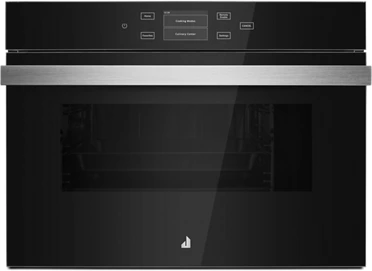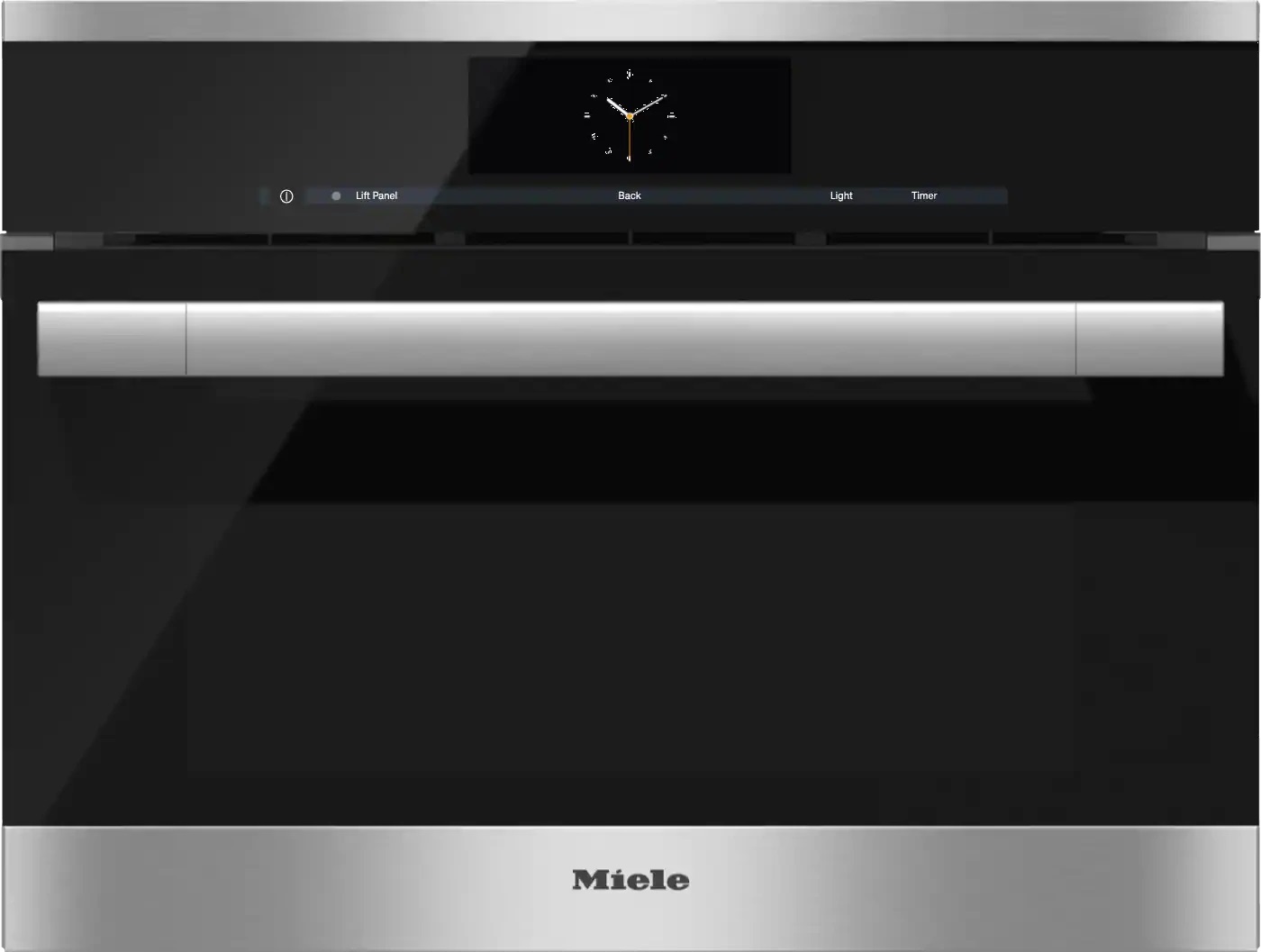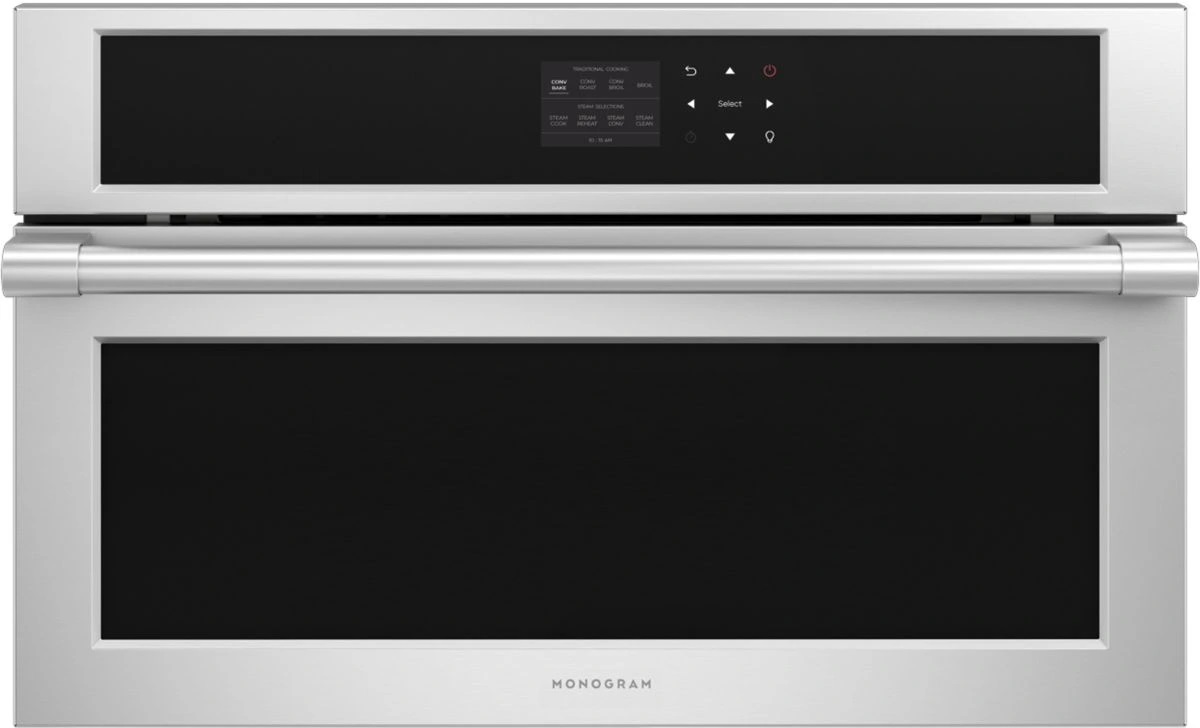If you enjoy steamed dumplings, freshly cooked fish, or classic sticky rice, you may be a fan of steam cooking without even realizing it. The cooking method has been around for centuries, but steam has been reinvented with the introduction of steam ovens.
Once available only to shoppers with the biggest budgets, ovens with steam modes have made their way into the public market, and buyers are becoming curious. What’s the appeal? Is a steam oven worth it? The (relatively) new oven feature is slowly but surely creating a buzz in the industry, so to keep you ahead of the trend, we’re giving the steam oven the spotlight.
To discover the benefits, considerations, and models we recommend, follow along!
At a Glance:
Advantages of Using a Steam Oven
Like you, food fanatics have been asking, “what is a steam oven?” ever since models first hit the public market more than two decades ago. Back then, Gaggenau was the only brand to offer this type of wall oven. Now, buyers have access to a wider range of models from brands like Miele, Bertazzoni, Bosch, and Monogram.
The way a steam oven operates is actually simple. Like a conventional oven, radiant heat circulates hot air throughout the oven chamber in the traditional style of baking. But when the steam mode is selected, moisture is injected into the oven, creating a completely unique baking setting previously only used in professional kitchens.
Steam ovens have yet to go mainstream and are marketed as a luxury appliance for gourmet kitchens, with prices beginning around $2,000 for starter models. Similar to wall ovens, built-in steamer ovens come in 24-inch and 30-inch options but are currently limited to single configurations only.
Related: How Much Oven Capacity Do You Need?
How Does a Steam Oven Work?
With one of these new appliances, learning how to steam in oven is as easy as placing items into the oven and running the steam mode. Depending on the model, water vapor is added into the main chamber either from a water line connected directly to kitchen plumbing or from a water canister that users manually fill.
Keep in mind, professional installation is recommended for steam ovens that connect to kitchen water supplies. Of course, that also means you can expect an added installation cost on top of the price of the appliance, a large reason why many shoppers prefer steam ovens with a water tank instead.
Benefits of a Steam Oven
What buyers ask even more is “why do I need a steam oven?” Can’t I just add water to my regular oven? In short, no, because pouring water directly to the bottom of an oven can result in damage to the baking element if it’s not hidden. Plus, the system used on steam ovens distributes moisture at an even pace, so food stays hydrated throughout the whole cooking process.
The next best option is filling a large dish with water in a bain-marie method, but…
- That takes up valuable oven space.
- The results are not the same.
Direct steam injection is not only simpler, but it comes with several advantages, including:
- Juicier results
- A healthier cooking alternative (less oil is needed)
- Faster cook times
- Replicates professional bakery ovens
- Helps keep food messes from caking on the oven interior
- Lock in nutrients from foods
What is a Steam Oven Best For?
Steam baking isn’t appropriate for every style of cooking, such as custards, cakes, or crispy items, but there are still several reasons to consider upgrading to one of these ovens. If any of these apply, we encourage you to browse steam ovens.
If you’re looking to practice a healthier lifestyle
Like oil, water is a conductor, which helps cook food faster than air. By swapping oil for water, a steam oven can help keep calories down by reducing the amount of fat needed during cooking. It’s also a great way to steam up rice and grains with virtually no maintenance other than popping the pot in and running the steam mode.
If you enjoy baking pastries
When cold butter and hot air come into contact in an oven, it creates lift. That’s what makes pastries so flaky, and adding steam is a great way to encourage that elevation. The result? Tender yet crispy layers you could only get before at the bakery.
If roasting is a regular cooking method in your home
Roasting large cuts of meats takes hours, and that could lead to over-drying the entrée. When steam is added, you get a layer of protection; while radiant heat crisps the exterior, steam penetrates the interior to keep it juicy.
Foods that are great for steam oven cooking include:
- Proteins like pot roasts or whole chickens
- Leftovers
- Rice and grains
- Artisan-style bread
- Seafood
- Dumplings
Steam Oven Pros and Cons
After exploring steam ovens, these are the major factors you should consider before buying a steam oven.
Pros ✓
✓ Healthier baking alternative
✓ Fast cook times
✓ Foods stay succulent
✓ Even heat
Cons ✗
✗ Smaller capacities
✗ More expensive than other ovens
✗ Require more cleaning
Steam Ovens We Love
Follow these three steam oven reviews to get a taste of what your kitchen could be missing out on.
Recommended Steam Oven: JennAir® NOIR™ 23.44" Floating Glass Black Electric Built In Single Steam Oven (JJW6024HM)

Shop Now
Our top built in steam oven comes from JennAir, masters of high-end, design forward kitchen appliances with nearly 75 years of experience in the industry. This 23-inch steam oven embodies some of the best the brand has to offer, including powerful convection with the best heat circulation in its class, plus the option to combine steam. Its sleek black exterior makes it the perfect addition to any modern kitchen.
Features:
- Total capacity: 1.3 cubic feet
- Temperature Probe
- Steam Plus Convection Mode
- 3.5-Inch Full-Color LCD Display
Recommended Steam Oven: Miele DGC 6700-1 24" Clean Touch Steel Combination Steam Oven (DGC 6700-1 CTS)

Shop Now
This Miele steam oven, also known as a combi steam oven, is our sleekest recommendation, with an elegant combination of black glass, stainless-steel hardware, and a refined control panel. Its presentation screams luxury, and with powerful oven features, your food will too. Explore new possibilities for dinnertime with MultiSteam technology, dual convection, and steam baking, plus even temperature control for dry sous vide cooking. Surprisingly, this 24-inch steam oven is the smallest on our list, but it also has the largest capacity.
Features:
- Total capacity: 1.84 cubic feet
- MultiSteam technology
- Convection + steam baking
- Sous vide mode
- Removable water reservoir
- PerfectClean interior finish
Recommended Steam Oven: Monogram Statement Collection 30" Stainless Steel Steam Oven (ZMB9031SNSS)

Shop Now
Celebrate old traditions with something new inside this Monogram Statement Collection 30-inch steam oven. It’s modern look is a feast for the eyes, and so will your favorite meals with the power of True European Convection that can be combined with steam for superior food results. This model comes with an integrated water line, so you can skip refilling the container and simply select the steam mode whenever you need.
Features:
- Total capacity: 1.3 cubic feet
- True European convection + steam baking
- 6-piece pan set included
- Built-in water system
Steam Oven FAQs
New technology comes with a lot of questions. Here are some common questions buyers ask about steam ovens.
Is a steam oven better than a microwave?
Shoppers are always curious about the steam oven vs microwave debate. In short, microwaves are undefeated when it comes to speed, but flavor and texture are far more superior in a steam oven. Overall, the inclusion of moisture guards food from over-cooking, while microwaves are notorious for rubbery food when left to cook too long.
How do you clean a steam oven?
While steam ovens are easier to clean, thanks to surfaces that stay wet, that condensation will need to be cleaned more frequently than a regular oven.
Here’s how we do it:
- First, remove cookware from the oven.
- Once the oven is empty, run a steam cycle for 15–20 minutes.
- Next, carefully wipe down the surfaces with a soft towel. Depending on how soiled the oven is, it may not be fully cleaned the first try.
- If there are still stains, spray the surface with an appropriate cleaner (check the manual) or with a paste made of baking soda and vinegar. Let it sit for 15 minutes
- After waiting, wipe down the surface once more. If there are still stains, repeat the process.
- When the majority of the interior is clean (minus a few spots to touch up next), run the steam cycle for another 10 minutes.
- Wipe down the surface, and tackle stubborn spots with a fine brush.
- When you’re satisfied, run the oven one final time, wipe again, and you’re done!
✓ Pro tip: Stay clear of soda-based oven cleaners. These can be too harsh for surfaces that aren’t properly coated, leading to damage.
Why Trust Us?
Founded in 1971, Don’s Appliances is a family-owned, independent appliance retailer based out of Pittsburgh, PA. Don’s has since expanded to 10 locations selling, delivering, installing, and servicing all major appliance brands. Large enough to offer competitive pricing yet small enough to continue offering the “white glove” service we pride ourselves on, our focus is always on the customer experience — from the first step into a showroom to the purchase transaction to well after your new appliance has been installed.
When our customers are remodeling or building a new house, Don’s has all the expertise, product knowledge, inventory, brands, displays, and services to meet and exceed your needs. And in the event an appliance breaks, we are there, right on time and with the right product, delivery, installation, and service.
Shop Steam Ovens at Don’s Appliances
Don’t put off until tomorrow what you can do today, and steam built-in ovens at Don’s Appliance. Our friendly experts are always happy to help you discover a steam oven for your lifestyle — whether you call us at 866-544-1711, email us, or use our online chat feature. Better yet, stop by any of our Don’s Appliances Pittsburgh, PA warehouse locations. Visit us today!
Learn More: More on Steam Cooking